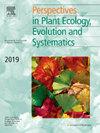A survey of duckweed species in Southern Italy provided first distribution records of the hybrid Lemna × mediterranea in nature
IF 2.9
3区 环境科学与生态学
Q1 ECOLOGY
Perspectives in Plant Ecology Evolution and Systematics
Pub Date : 2025-03-14
DOI:10.1016/j.ppees.2025.125863
引用次数: 0
Abstract
Interspecific hybridisation and polyploidization are two main driving forces in plant evolution, shaping genomes and favouring evolutionary novelty and ecological adaptation. Recent studies have demonstrated hybridisation within the genus Lemna (Lemnaceae Martinov) as well as triploid accessions. Lemna × mediterranea, a recently described hybrid between Lemna minor and Lemna gibba, was identified only among long-lasting germplasm collections of in vitro propagated plants, originally collected at different times in the Mediterranean area. We report the first distribution record of L. × mediterranea in the nature, in the Campania region of Southern Italy, the same area where Lemna symmeter was described as a new species about 50 years ago, confirming their synonymy. Eight specimens isolated from five different sampling sites over an area of about 4200 km2 showed identical genetic profiles by Tubulin-Based Polymorphism (TBP) analysis, suggesting their common origin from the same hybridisation event, followed by clonal dispersal. The L. × mediterranea population of Campania is genetically different from any of the previously analysed clones, suggesting that recurrent hybridisation between the parental species may occur. The natural hybrid clone is triploid, with L. gibba as the plastid donor, and remarkably similar to it by morphology, although the typical gibbosity of this species becomes evident only upon in vitro flower induction. Flowers are protogynous and self-sterile. Ecological factors including competition with parental and invasive species, niche and climate change adaptation, stability in time and space likely played a role in the successful establishment of L. × mediterranea.
对意大利南部浮萍种类的调查首次提供了地中海浮萍在自然界的分布记录
种间杂交和多倍体化是植物进化的两个主要驱动力,它们塑造了基因组,促进了进化的新颖性和生态适应性。最近的研究表明,在Lemna属(Lemnaceae Martinov)以及三倍体中存在杂交。lena × mediterranea是最近发现的一种小lena和长尾lena之间的杂交植物,仅在地中海地区不同时间收集的体外繁殖植物的长期种质中被鉴定出来。本文报道了在意大利南部坎帕尼亚地区首次记录到的L. x mediterranea在自然界的分布,该地区50多年前曾被描述为新种Lemna symmeter,证实了它们的同义性。在4200 km2的范围内,从5个不同的采样点分离的8个样本通过微管蛋白多态性(TBP)分析显示出相同的遗传图谱,表明它们共同起源于同一杂交事件,然后是克隆扩散。坎帕尼亚的L. × mediterranea种群在遗传上与之前分析的任何克隆都不同,这表明亲本物种之间可能会发生反复杂交。自然杂交克隆为三倍体,以长臂猿为质体供体,在形态上与长臂猿非常相似,尽管该物种的典型长臂猿只有在离体花诱导时才变得明显。花是原生的和自不育的。与亲本和入侵种的竞争、生态位和气候变化的适应、时间和空间的稳定性等生态因素可能对地中海L. xmediterranea的成功建立起了重要作用。
本文章由计算机程序翻译,如有差异,请以英文原文为准。
求助全文
约1分钟内获得全文
求助全文
来源期刊
CiteScore
6.50
自引率
0.00%
发文量
28
审稿时长
67 days
期刊介绍:
Perspectives in Plant Ecology, Evolution and Systematics (PPEES) publishes outstanding and thought-provoking articles of general interest to an international readership in the fields of plant ecology, evolution and systematics. Of particular interest are longer, in-depth articles that provide a broad understanding of key topics in the field. There are six issues per year.
The following types of article will be considered:
Full length reviews
Essay reviews
Longer research articles
Meta-analyses
Foundational methodological or empirical papers from large consortia or long-term ecological research sites (LTER).

 求助内容:
求助内容: 应助结果提醒方式:
应助结果提醒方式:


